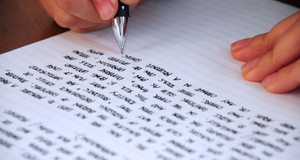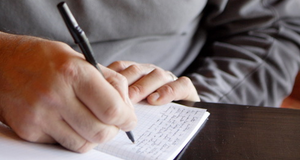|
English Student Resource Guide: Annotated Bibliography of Four General Dictionaries
This bibliography will be especially helpful to beginners who wish to begin a comparative study of dictionaries or philosophies of grammar. The information presented about each dictionary is as follows:
- Whether the dictionary is descriptive (describing common usage), prescriptive (prescribing accurate usage), or ambivalent.
- What aspects of the dictionary support that it is a descriptive, prescriptive, or ambivalent dictionary.
- The scope and special features of the dictionary.
The American Heritage College Dictionary. 4th ed. Boston: Houghton Mifflin, 2002.
- Ambivalent.
- Is not consistent in maintaining distinctions between often confused words. Maintains distinctions for these often confused words: alright/all right, disinterested/uninterested, affect/effect, but not for these: anxious/eager, nauseous/nauseated, enormousness/enormity. The usage notes are ambivalent. For example, the usage note for affect is prescriptive: “Affect and effect have no senses in common.” The usage note for anxious is descriptive: “Anxious has a long history of use roughly as a synonym for eager, but many prefer that anxious be used only when its subject is worried or uneasy about the anticipated event.” The usage labels sometimes give clear indication of what is Standard English. The introductory material says of the label nonstandard, “This, the most restrictive label in the dictionary, is applied to forms and usages that educated speakers and writers consider unacceptable.” The AHCD sometimes tells what is correct, but sometimes only tells what is generally accepted. Remarks in the introductory matter indicate that the work is ambivalent. The introductory article explains prescriptively the reason for the large number of usage notes: “there are many more ways of getting a word wrong than of getting it right.” However, it also makes descriptive statements, such as, “What draws us together as speakers of English is not our sameness but our ability to find in our differences the occasion for lively critical discussion.”
- Does not state how many entries, but does state that there are 7,500 new words and senses. Emphasizes new words, such as “many new computer and Internet terms along with newly coined words in science, politics, and the arts.” Definitions are arranged by frequency of usage, that is, with the most commonly sought meanings first. Biographical and geographical entries are listed alphabetically with other entries. Includes over 300 usage notes. Other features include the introductory article “Usage in The American Heritage Dictionary” and 2,500 new photographs, drawings, and maps. It also includes biographical entries for currently prominent people, and new statistics from the 2000 census. Contains Word History notes and a unique Appendix of Indo-European Roots.
Microsoft Encarta College Dictionary. New York: St. Martin’s Press, 2001.
- Prescriptive.
- Does insist on maintaining distinctions between often confused words: anxious/eager, nauseous/nauseated, disinterested/uninterested, alright/all right, flaunt/flout, allusion/illusion. The usage notes are prescriptive. For example, the note for flaunt says, “In terms of openly disobeying or defying a law or convention, only flout is the correct choice.” The note for all right says of all right, “Use instead all right, which has all the meanings, including ‘satisfactory,’ associated with alright.” The usage labels give clear indication of what is Standard English. For example, the usage label for ain’t is nonstandard, a label which is defined in the introductory notes as “not considered part of correct or educated usage, though current in spoken usage.” Remarks in the introductory matter indicate that the work is prescriptive. The introductory article “Usage in Crisis” says, “A good many of the errors highlighted above are not addressed by current dictionaries . . . because dictionary editors are obviously unaware of the severity of the problem. . . . It is our hope that the Usage Notes and other language guidance in the Microsoft Encarta College Dictionary . . . will help all North American students meet the expectations of their instructors.”
- Contains over 90,000 entries, including 5,000 new entries. Emphasizes high-technology words. Definitions are arranged by usage and frequency. Approximately 10,000 biographical and geographical entries are located alphabetically with other entries. Contains over 600 usage notes. Other features include the introductory articles “Usage in Crisis?” by Anne Soukhanov and “The Internet as a Research Tool” by Andrew Harnack and Gene Kleppinger. Contains 140 “Literary Links” and approximately 70 “Quick Facts” charts. Lists over 700 incorrect spellings that refer the reader to the correct spelling, and has 400 “Spellchecks” at words pronounced alike but spelled differently. Contains several tables, and many small black and white photographs near entries.
The Oxford English Dictionary. 2d ed. 20 vols. Oxford: Oxford University Press, 1989.
- Descriptive/Historical.
- The purpose of this work is historical.
- Contains 59,000,000 words and 5,000 new words; contains 290,500 entries and 41,752 new entries. Aim is to record every English word from its first appearance to the present. Definitions are arranged chronologically, and then by usage. Contains a few broad biographic and geographic entries located alphabetically with other entries. Has no usage notes, but has usage labels, including the strongest label: illiterate. Time period covered is from 1150 to present (1989). This second edition has 20 volumes, with 4 supplemental volumes; was originally 12 volumes. Other features include an introductory article “The History of the Oxford English Dictionary,” and a vast number of quotations: 2,412,400 in the twenty volumes, 33,300 of which are from Shakespeare, and 25,000 of which are from the Bible. Longest entry is “set,” with 430 senses. Is most exhaustive English dictionary, and played a key role in preserving English language.
Webster’s Third New International Dictionary. Springfield, MA: G. & C. Merriam, 1961.
- Descriptive/Liberal.
- Does not insist on maintaining distinctions between often confused words: anxious/eager, nauseous/nauseated, flaunt/flout, disinterested/uninterested, alright/all right, cupfuls/cupsful, deprecate/depreciate. The usage notes are descriptive. For example, the definition of nauseous says, “Affected with or inclined to nausea: nauseated.” The definition of disinterested says, “Lacking or revealing lack of interest . . . uninterested.” Includes misspelled words as standard spellings. For example, the usage note for alright says, “In reputable use although all right is more common.” It only states what is common, not what is correct. Includes mispronunciations as standard pronunciations. The WTNID is very liberal on pronunciation. Its pronunciation note for a second pronunciation of nuclear simply says, “Chiefly used in substandard speech.” In the explanatory notes, substandard is defined as “usage that exists throughout the American language community.” The usage labels do not give clear indication of what is Standard English. The preface tells us that the dictionary “does not attempt to dictate what usage should be.” For example, ain’t is not labeled colloquial, informal, or substandard. The note for ain’t says, “Though disapproved by many and more common in less educated speech, used orally in most parts of the U.S. by many cultivated speakers esp. in the phrase ain’t I.” Remarks in the introductory matter indicate that the work is descriptive. Philip Gove writes, “Accuracy in addition to requiring freedom from error and conformity to truth requires a dictionary to state meanings in which words are in fact used, not to give editorial opinion on what their meanings should be.”
- Contains over 450,000 words, but does not give the number of entries or new entries. Aim is “nothing less than coverage of the current vocabulary of standard written and spoken English.” Scientific and technical vocabulary has been expanded. Definitions are arranged chronologically, then by most common use. Biographical and geographical entries are omitted. Number of usage notes not stated. Other features include illustrations beside entries, as well as full-page color illustrations. There is also “the incorporation of abbreviations alphabetically in the main vocabulary.” Over 200 consultants worked on the dictionary.
Save Citation » (Works with EndNote, ProCite, & Reference Manager)
APA 6th
Jennings, E. A. (2010). "English Student Resource Guide: Annotated Bibliography of Four General Dictionaries." Inquiries Journal/Student Pulse, 2(10). Retrieved from http://www.inquiriesjournal.com/a?id=307
MLA
Jennings, Elizabeth A. "English Student Resource Guide: Annotated Bibliography of Four General Dictionaries." Inquiries Journal/Student Pulse 2.10 (2010). <http://www.inquiriesjournal.com/a?id=307>
Chicago 16th
Jennings, Elizabeth A. 2010. English Student Resource Guide: Annotated Bibliography of Four General Dictionaries. Inquiries Journal/Student Pulse 2 (10), http://www.inquiriesjournal.com/a?id=307
Harvard
JENNINGS, E. A. 2010. English Student Resource Guide: Annotated Bibliography of Four General Dictionaries. Inquiries Journal/Student Pulse [Online], 2. Available: http://www.inquiriesjournal.com/a?id=307
Suggested Reading from Inquiries Journal
Remarks in the introductory material indicate that the philosophy of the work is prescriptive. For example, in the introductory article “On Usage, Purism, and Pedantry,” Follett says, “Skill in expression consists in nothing else than steadily choosing the fittest among all possible words, idioms, and constructions.” In the introductory article “On the Need of Some Grammar,” he states, “What... MORE»
Written language is one of the greatest human accomplishments; its formation signifies a breakthrough in human progress. The development of a standardized writing system seems to be a somewhat natural occurrence in the evolution of any given advanced society. It can be observed that, as a culture or a people grow and expand in other... MORE»
English grammar learning is challenging but essential for English-as-a-second-language (ESL) learners. It is vital for ESL learners to develop effective learning strategies to facilitate grammar learning. The efficacy of the incorporation of a learners' first language (L1) in English grammar learning is in doubt. This article investigated... MORE»
Throughout the American education system, the assessment of writing skill and general academic performance through timed essay examinations has become increasingly pervasive, contributing to the determination of grades and course placements and ultimately affecting college admissions through their use in standardized tests. In March... MORE»
Latest in Literature
2023, Vol. 15 No. 02
This literary analysis compares the spiritual landscape of Aldous Huxley’s Brave New World against his nonfiction work, The Perennial Philosophy. In Brave New World, Huxley’s World State appears spiritually promising. It embeds self-... Read Article »
2022, Vol. 14 No. 09
Woolfian Scholars regularly denote the moments where Woolf’s characters feel inexplicably connected and inseparable from one another as representing the spiritual and mystic beliefs of their author. I want to reframe this notion, considering... Read Article »
2022, Vol. 14 No. 09
The Goldfinch (2013) by Donna Tartt is a novel that explores the conditions of grief and escalating lengths characters will go to survive the traumas and mysteries of life. This story of guilt and loss—intermixed with love and longing&mdash... Read Article »
2022, Vol. 14 No. 04
British Poet Laureate Carol Ann Duffy’s The World’s Wife presents a fresh outlook on myths and fairy tales, by retelling them through sociosexually liberated women. The poems feature many themes such as murder, sexuality and childhood... Read Article »
2022, Vol. 14 No. 04
The 17th and 18th centuries saw a wide proliferation of aesthetic discourse through which the picturesque emerged to capture the type of beauty derived from the exchange of in vivo vigor for the spirit of artistic medium. While the metaphysical... Read Article »
2022, Vol. 14 No. 03
This paper explores the complexity of Whitman’s nationalism and, with reference to Leaves of Grass (1856), examines the apparent paradox between Whitman’s poetry of love and recognition and his imperialistic impulses. This paper draws... Read Article »
2022, Vol. 14 No. 02
This article explores the expression of the Gothic romance genre in the 21st century, by examining Mike Flannagan’s The Haunting of Bly Manor. Very little literature focuses on contemporary expressions of this genre. The Gothic reflects the... Read Article »
|

















